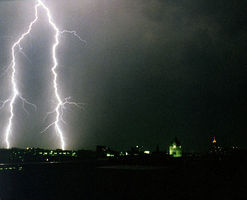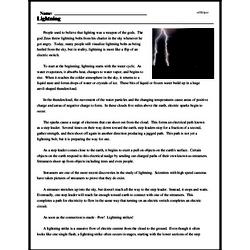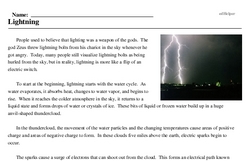Lightning
People used to believe that lighting was a weapon of the gods. The god Zeus threw lightning bolts from his chariot in the sky whenever he got angry. Today, many people still visualize lightning bolts as being hurled from the sky, but in reality, lightning is more like a flip of an electric switch.
To start at the beginning, lightning starts with the water cycle. As water evaporates, it absorbs heat, changes to water vapor, and begins to rise. When it reaches the colder atmosphere in the sky, it returns to a liquid state and forms drops of water or crystals of ice. These bits of liquid or frozen water build up in a huge anvil-shaped thundercloud.
In the thundercloud, the movement of the water particles and the changing temperatures cause areas of positive charge and areas of negative charge to form. In these clouds five miles above the earth, electric sparks begin to occur.
The sparks cause a surge of electrons that can shoot out from the cloud. This forms an electrical path known as a step leader. Several times on their way down toward the earth, step leaders stop for a fraction of a second, gather strength, and then shoot off again in another direction producing a jagged path. This path is not yet a lightning bolt, but it is preparing the way for one.
As a step leader comes close to the earth, it begins to exert a pull on objects on the earth's surface. Certain objects on the earth respond to this electrical nudge by sending out charged paths of their own known as streamers. Streamers shoot up from objects including trees and even people.




